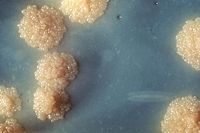Mycobacterium tuberculosis
Articles that lack this notice, including many Eduzendium ones, welcome your collaboration! |
 | ||||||||||||||
| Scientific classification | ||||||||||||||
| ||||||||||||||
| Binomial name | ||||||||||||||
| Mycobacterium tuberculosis |
Description and significance
Mycobacterium tuberculosis was first isolated and described in 1882 by Dr. Robert Koch, who later went on to win the Nobel Prize in 1905 for his discovery. Also known as, "Tubercle Bacillus", and Koch's bacillus, M. Tuberculosis is a non-motile, rod shaped bacterium, and the primary cause for the widespread disease tuberculosis.
The World Health Organization estimates that one-third of the world's population is infected with M. Tuberculosis, and that someone new is infected every second. [1] With the emergence of drug resistant strains, both multi drug resistant (MDR) and extensively drug resistant (XDR), controlling the spread of tuberculosis has become a major concern. Since 2006, the WHO's primary strategy in its Stop TB Strategy has been the use of DOTS (Directly Observed Treatment, Short-course). It is estimated to be the most cost effective strategy, only costing $3-$7 to gain a year of health. [2]
Genome structure
Describe the size and content of the genome. How many chromosomes? Circular or linear? Other interesting features? What is known about its sequence? Does it have any plasmids? Are they important to the organism's lifestyle?
- Double stranded circular DNA.
Chart from "http://genolist.pasteur.fr/TubercuList"
| DNA Molecule Summary | ||
| Total Number of all DNA molecules: | 1 | 100.00% |
| Total Size of all DNA molecules: | 4403837 bp | 100.00% |
| Number of Primary Annotation coding bases: | 4069477 bp | 92.40% |
| Number of G+C bases: | 2889216 bp | 65.60% |
| Primary Annotation Summary | ||
| Total genes: | 4294 | 100.00% |
| Protein coding genes: | 4246 | 98.88% |
| Genes assigned a role category: | 2317 | 54.56% |
| Genes not assigned a role category: | 2 | 0.04% |
| Conserved hypothetical genes: | 655 | 15.42% |
| Hypothetical genes: | 1272 | 29.95% |
| tRNA genes: | 45 | 1.04% |
| rRNA genes: | 3 | 0.06% |
Cell structure and metabolism
(Temporary General Outline)
- Obligate Aerobe: Explains why it infects the upper lobes of the lungs
- Slow rate of growth compared to other bacteria (about 15-20 hours)
- Non-motile rod shaped
- Size: ~2-4 um in length and 0.2-0.5 um in width
- Acid-fast staining is used (specifically Ziehl-Neelsan Stain)
- Cell wall: peptidoglycan but note 60% lipid (Mycolic Acid, Cord Factor, Wax-D) High lipid percentage results in a lot of interesting properties: (impermeability to stain; different kinds of resistances (antibiotics, osmotic lysis, acidic and alkaline compounds, oxidation).
Ecology
Describe any interactions with other organisms (included eukaryotes), contributions to the environment, effect on environment, etc.
Pathology
(Temporary General Outline)
- Major cause of tuberculosis (can link to tuberculosis page later)
- Binding to mannose receptors (for entry into cell)
- Ability to prevent lysosome from fusing with phagosome, as a result prevents the destruction of the bacteria.
- Slow generation may actually help the bacteria from being detected by the immune system.
- Cell wall construction is 60% lipid. Lot of different types of resistances.
- Antigen 85: binds to fibronectin and may help in protecting the bacteria from the immune system.
- Interference with oxygen intermediates
Application to Biotechnology
Does this organism produce any useful compounds or enzymes? What are they and how are they used?
Current Research
Summaries to come
Pubmed article about BCG vaccine
Pubmed article about the discovery of lipolytic enzymes which may be involved with virulence
Article concering multi-drug resistant mycobacterium tuberculosis
